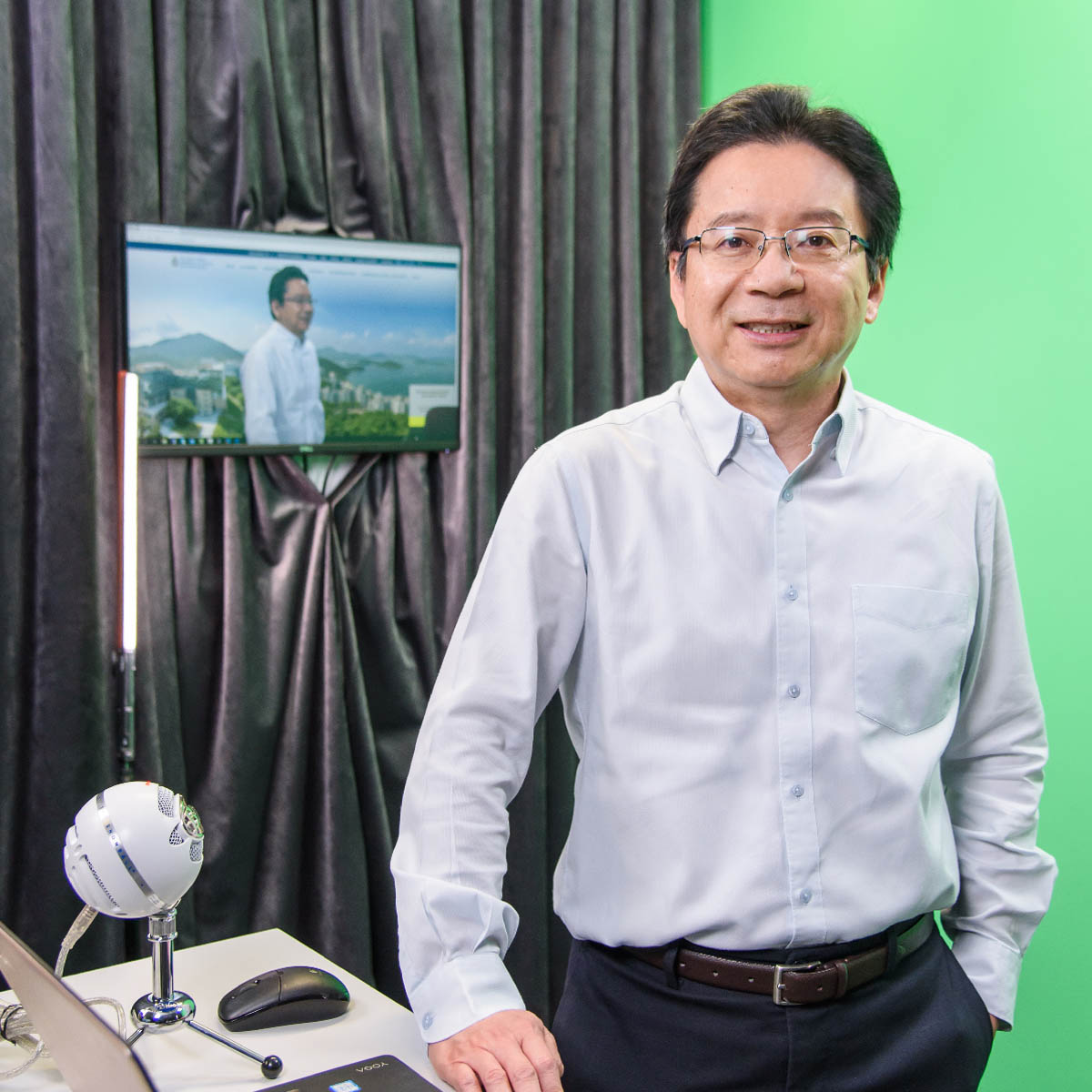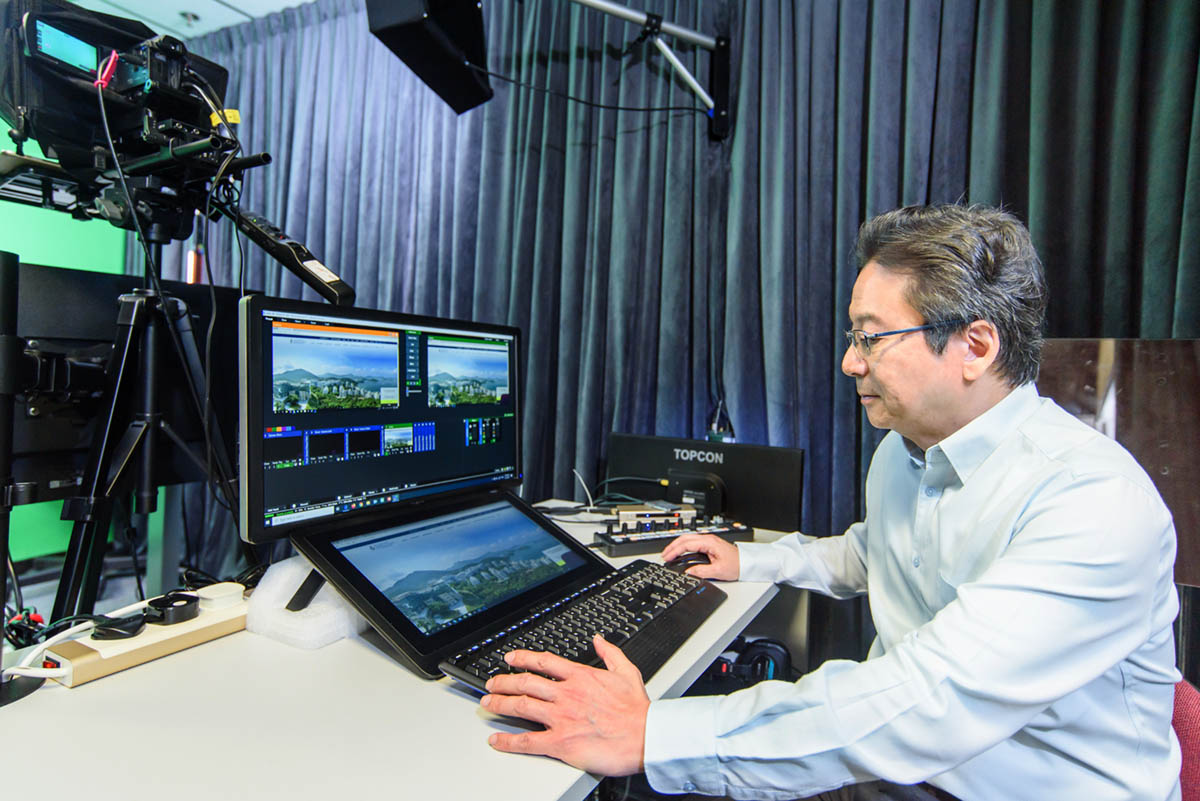

Professor Ting Chuen Pong is an expert in e-learning. The Professor of Computer Science and Engineering and Senior Advisor to the Provost explains how HKUST was ready to meet the educational challenges presented by COVID-19 and what the future holds for face-to-face learning.
Early Days
When Professor Pong got involved with e-learning while teaching at the University of Minnesota more than 30 years ago, it was done via satellite. Alternatively, a lecture would be recorded onto a VHS tape and mailed to students. It was progressive for the time.
Pong has remained at the forefront of e-learning. Almost twenty years ago, having joined HKUST in 1991, he started the Cyber University program to offer credit-bearing courses to high achievers in secondary schools via a combination of online and face-to-face learning.
In the years that followed, Pong and HKUST were involved in e-learning in a variety of ways, and by the time SARS hit in 2003, the University was prepared to take learning online. “We were ready, but the technology was not. We did video recording but it was difficult to deliver live interactive online learning,” says Pong.
These early experiences provided a prime opportunity to keep the momentum going, but human beings often resist change, so post SARS classes resumed more or less as normal, only with more lectures being recorded. But Pong continued his work. In 2006, he was involved in the Hong Kong Virtual University project, which built on the Cyber University, collaborating with other local universities to offer more credit-bearing courses to university and secondary school students. HKUST developed an innovative learning management system that received awards in Natural Sciences and Hybrid Learning at the Wharton-QS Stars Awards in 2014.
Leading the Way
The rise of e-learning globally was also taking place, and in 2012 HKUST became the first university in Asia to offer Massive Open Online Courses (MOOCs) in partnership with Coursera and later edX. MOOCs provide flexibility, especially for adult learners who can choose courses and learn anytime. Since 2013, HKUST has offered 60 MOOCs attracting more than 1.8 million learners, including Pong’s Java programming course that attracted over 400,000 learners, and the courses have proved enduringly popular. In May this year, for example, HKUST’s edX course ‘Build a foundation for creating Java and Android apps’ was named by Android Headlines as one of the 5 Best Courses Online to Learn Android Development.
Through the provision of MOOCs, HKUST was able to develop a system called VisMOOC and embed it in HKUST’s own HKMOOC platform, which Pong launched in 2015 as a place for local universities to offer MOOC-based courses online. VisMOOC can be used to analyze students’ learning process. “HKUST has developed learning analytics tools to understand how students learn and how we can improve delivery,” says Pong.
This helped when, in November last year, HKUST was forced to make all of its courses available online to students due to social unrest in the city.
“Starting from mid-November, we converted all our courses to online,” says Pong. This was also when HKUST became an early adopter of Zoom, using it to deliver online learning. At that stage, no one knew what 2020 would bring, but these preparations would prove to have come at an opportune time.
Challenges and Innovation
With the onset of COVID-19, Zoom became the primary means for all courses at HKUST to be delivered using the live interactive online mode. With its ability to mimic face-to-face lectures with functions for group discussion, polling, raise hand and share screen, even those with little experience have been able to adapt. And where digital functionality has not met requirements, this has led to creative thinking, with students and teachers coming up with their own ways to, for example, create visualizers that allow for the projection of content that might have been written on a white board during a lecture.
“We asked students to come up with their own designs in a design thinking workshop. They were at home, so we asked them to use whatever material they could find and they came up with very interesting designs, using coat hangers to anchor the camera for example. I think when you are facing challenges, you can see more innovative ideas,” says Pong.
Despite the many positive outcomes of online learning, Pong doesn’t believe the computer will ever fully replace the classroom, but instead the two will co-exist. “I am all for online teaching and learning, but you have to have a face-to-face component, if the situation allows,” says Pong. He advocates for the “flipped classroom” approach which reverses the teaching and learning process, encouraging students to learn independently first, which means they can go at their own pace, before active learning in the classroom. “The classroom setting provides students with more quality interactive time and active engagement. This kind of learning environment helps students retain the information for longer. If students are involved in the learning process it makes them truly understand and that is what we want.”

The global pandemic has encouraged the development of other online learning initiatives. In March, Pong launched the e-STEAM@Home scheme to allow secondary school students to pursue award certificates and get a taste of university education. With many young students already used to aspects of e-learning and having grown up as digital natives, it has been well received with more than 2,000 students enrolled on various courses.
Additionally, the Global Virtual Exchange program has allowed students to take courses from HKUST’s partner institutions around the world online as COVID-19 put a stop to physical exchange.
The Future of Education
E-learning has come a long way in the last three decades, though there’s room for more. “We don’t have a good solution for online assessment yet,” says Pong. “It is too exam-oriented and the questions are recall-type questions, testing students on whether they can remember. That’s not the way to really measure learning.”
There is also potential for the use of Artificial Intelligence and Virtual Reality in e-learning. With so much data being collected, AI could be used to analyze learning patterns to allow for improvements and the creation of intelligent tutors. Meanwhile, VR is being developed to allow students to perform experiments through virtual lab technology and the use of VR head-mounted displays.
But whatever happens post-pandemic, there will be a return to classrooms. “With AI and all these other developments, you can deliver knowledge, but it’s for a human teacher to really inspire the students, to really motivate them,” says Pong. And that is something that’s irreplaceable.
In 2012 HKUST became the first university in Asia to offer Massive Open Online Courses (MOOCs) in partnership with Coursera and later edX.
Since 2013, HKUST has offered 60 MOOCs attracting more than 1.8 million learners, including Pong’s Java programming course that attracted over 400,000 learners,
The innovative learning management system received awards in Natural Sciences and Hybrid Learning at the Wharton-QS Stars Awards in 2014.
More than 2,000 students enrolled on various courses under the newly launched e-STEAM@Home scheme in 2020.
edX course ‘Build a foundation for creating Java and Android apps’ was named by Android Headlines as one of the 5 Best Courses Online to Learn Android Development in 2020.
The Coursera for HKUST scheme allows our alumni to enjoy a certificate charge waiver when undertaking MOOCs. This pilot scheme aims to promote e-learning as a means of lifelong, self-directed learning.
Learn more
